Inflatable facilities communicate with many as a source of entertainment for children, on birthdays or in amusement parks. Further thought will probably bring up other familiar applications, such as lifeboats, emergency slides for airplanes and airbags for cars
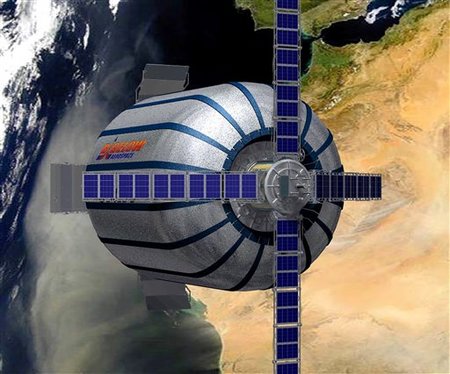
Using inflatable components in space appears at first thought as a curiosity, or as an application that is not suitable for the harsh conditions of the space environment. And here, inflatable structures - although not common yet - are in space around the earth as part of satellites, as experiments to test various technologies and even as a prototype for a commercial space station.
In this review, we will deal a little with the various applications of inflatable space structures, the technological challenge facing those who want to use them in space, and future plans that expect inflatable structures to have an important future in human activity in space.
What are inflatable components?
There are many space applications that can make use of inflatable components, and here is a partial list: part of a spacecraft or satellite structure, for example a frame on which photovoltaic cells ("solar cells") are installed, an antenna skeleton, a shield against micrometeorites and space debris debris ( (Space Debris. A degradable heat shield before entering the atmosphere, a means of hiding a satellite and making it stealthy, and even a living unit or laboratory that allows the existence of humans inside it.
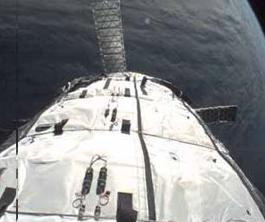
The tasks that can be performed using inflatable space components are many, but we must overcome the many obstacles found in the space environment such as vacuum, ionizing and non-ionizing radiation, the risk of impact by tiny meteorites and man-made space debris, dealing with atomic oxygen - these are all difficult obstacles. Even for satellites and rigid systems, it is easy to use a flexible material inflated with some gas.
The variety of applications that can be performed using inflatable components brought private entrepreneurs to deal with this issue, as well as the European Space Agency, which even holds an annual scientific conference dealing with inflatable space components. The American space agency NASA is also examining the use of these components.
looking back

It is interesting to note that one of the first satellites in the world was actually an inflatable satellite. The American space agency NASA launched into space in May 1960 the satellite Echo-1 (Echo-1), a sphere with a diameter of thirty and a half meters, made of polyester and coated with aluminum. The thickness of the shell was only 0.127 mm(!).
The satellite was used as a relay station for radio and television signals, as well as for transmitting telephone calls (in other words: the satellite was a passive communication satellite). In addition, the satellite was used as a tool for studying the density of the Earth's atmosphere and the intensity of the sun's radiation.
The satellite survived in space for eight years and finally burned up in May 1968 upon entering the atmosphere. NASA used this technology to launch a small number of similar satellites, but with the development in the field of active communication satellites, the issue was abandoned.
Air bags for landing spacecraft
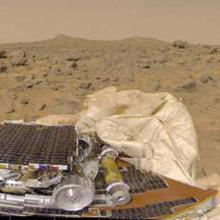
The accepted form of landing spacecraft on Mars includes several stages: aerodynamic braking - using the Martian atmosphere to slow down the landing chamber, parachute, and rocket braking engines that operate until the lander touches the surface of Mars. Using rocket engines for landing inevitably involves carrying the fuel and oxidizer necessary for landing - a significant mass, which if not carried would have been possible to increase the weight of the scientific equipment on the spacecraft or alternatively to use a smaller launcher (missile), and save on the costs of the entire mission.
In 1997, for the first time ever, a research spacecraft landed on Mars without landing legs and rocket braking motors. The spacecraft, Pathfinder, used aerodynamic braking and a parachute, but in the final stage of the landing process, airbags were inflated around the lander, and they absorbed the shock of impact with the ground. The spacecraft bounced and bounced on Mars several times until it stopped.
The private space company Bigelow Aerospace is engaged in the development of inflatable space stations, with the intention of providing accommodation for space tourists, when space tourism becomes orbital. At this point the compressed gas that was used to inflate the cushions was emptied, and a small research robot could go to the surface and start its work.
In 2004, the US landed two advanced robots on Mars using the method of cushioning the landing using air bags. It is understood that these cushions had to withstand the erosion of the Martian soil, and be immune to tears that could have been caused by sharp stones and rocks. In terms of structure, the pillow case was similar to the space suits of the astronauts. Britain also tried its hand at this landing method, but contact with the Beagle 2 spacecraft was lost and there is no information whether there was a failure in the inflatable landing mechanism or whether the mission failed at an earlier stage.
Stealth satellite
A simplified drawing appearing in a US patent shows a large intelligence satellite with most of it hidden by a cone. The cone is an inflatable component, designed to hide the structure of the satellite from ground observations using powerful telescopes.
In addition to preventing visible light photography, the inflatable cone is used to reduce the infrared signature of the satellite, its radar signature and even to be an obstacle to small photography satellites that will operate near the satellite (for satellites for proximity operations in space see here). It is not known whether there are American satellites that use this technology for stealth purposes, but the accepted opinion among many space experts is that such satellites do exist.
Huge antennas and solar cells
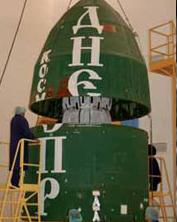
An inflatable skeleton can form the basis of huge antennas suitable for communication satellites and certain spy satellites. The low weight of the structure, compared to rigid structures, and the possibility of producing structures with variable geometry, led the American space agency as well as various private companies to develop inflatable antennas for satellites.
On the space shuttle flight STS-77 (May 1996) a large antenna with an inflatable skeleton was deployed with great success. Some Japanese communication satellites also used this technology. The ILC DOVER company developed solar cells stretched on inflatable frames, but today there is still no satellite that uses them. These structures are of great importance in terms of weight saving, a factor that will be a consideration in the planning of future solar sails.
Inflatable space stations for tourists
One of the most interesting private space companies is Bigelow Aerospace. The company is engaged in the development of inflatable space stations, with the intention of providing housing for space tourists, when space tourism will become orbital (today, most initiatives for space tourism deal with sub-orbital flight, i.e. a large arc performed by the spacecraft, culminating in a few minutes' stay in space). Inflatable heat shields can be used as lifeboats in an emergency, reducing the weight of equipment sent to the International Space Station
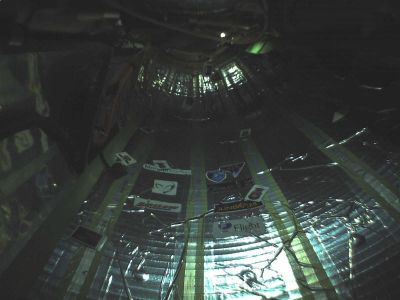
The rich space tourists will not be happy to be squeezed into the limited and spartan space of the International Space Station, and this is where the Bigelow company came into action. The private company has already sent a component into space that inflated and created an assembly suitable for living and working and similar in size to a minibus.
The company has plans to send additional units into space, in order to assemble the first private space station that can be used as a destination for space tourists. Genesis 1, the company's first unmanned space station, has been successfully operating in space since 2006, and has not experienced any significant malfunctions, including loss of compression. In 2007, a larger space station, Genesis 2, was launched, which is also operating properly.
Inflatable structures for lunar exploration
As part of the current strategy of the American space agency to return to the moon and establish a base for prolonged manned activity on its surface, inflatable residential buildings in various configurations are being tested. The veteran company that developed and manufactured the US space suits from the beginning of manned space flights, ILC DOVER, is developing the inflatable living units, which according to the plan will be placed on the moon at the end of the next decade, and may also be used by the first crews to land on Mars.
Inflatable structures for atmospheric containment
Despite the fact that they have not yet been put to operational use, there are technological solutions based on inflatable structures that can assist in the atmospheric containment phase when landing research spacecraft on Mars, and even for returning spacecraft and equipment from space to Earth.
Despite the immense heat upon entering the atmosphere, the inflatable structures are able to survive the transition. Inflatable heat shields can be used as lifeboats in an emergency, reducing the weight of equipment sent to the International Space Station.
And so it seems that inflatable space components could be used for a variety of space applications, simplify the technical aspects of various space missions and lower the costs of these missions, and especially shorten the research and development time of components that deviate from conventional design. We may not see inflatable rockets anytime soon, but inflatable satellites, inflatable space stations and even a spacecraft designed to move in the "line" between the space station and the moon - definitely yes.
Tal Inbar is the head of the Center for Space Research, the Fisher Institute for Strategic Air and Space Research, and the chairman of the Israel Space Association. The article was published in Issue 123 of the Galileo journal
- Company website Bigelow Aerospace, with a detailed description of the inflatable space stations as well as photos and videos taken on the unmanned Genesis 1 space station.
- The European Space Agency's conference website dealing withInflatable space components.

5 תגובות
Tal, I enjoyed reading. very interesting.
I don't understand what material will withstand the inflation of one atmosphere (for residential units). This is a cumulative pressure of millions of kg.
A combination between a zeppelin and a levine could possibly replace or reduce a rocket launch.
Reminds me of the zeppelin.. it was also swollen in the construction of the aircraft carrier means. 🙂
It sounds like a good idea and seems suitable for streamlining many processes and activities